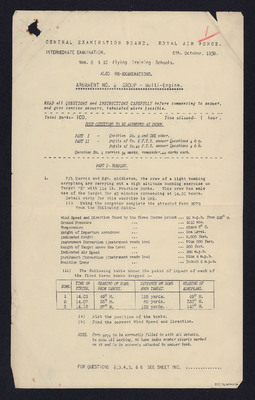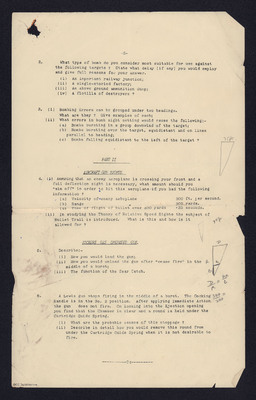RAF Exam Paper
Title
RAF Exam Paper
Description
An intermediate examination dated 6 October 1939.
Creator
Date
1939-10-06
Temporal Coverage
Language
Format
Two typewritten sheets
Publisher
Rights
This content is available under a CC BY-NC 4.0 International license (Creative Commons Attribution-NonCommercial 4.0). It has been published ‘as is’ and may contain inaccuracies or culturally inappropriate references that do not necessarily reflect the official policy or position of the University of Lincoln or the International Bomber Command Centre. For more information, visit https://creativecommons.org/licenses/by-nc/4.0/ and https://ibccdigitalarchive.lincoln.ac.uk/omeka/legal.
Contributor
Identifier
MHitchcockJS740899-170926-040001, MHitchcockJS740899-170926-040002
Transcription
[inserted] 1/ [/inserted]
CENTRAL EXAMINATION BOARD, ROYAL AIR FORCE.
INTERMEDIATE EXAMINATION. 6th. October, 1939.
Nos. 8 & 10 Flying Training Schools.
ALSO RE-EXAMINATIONS.
[underlined] ARMAMENT NO. 2 GROUP – Multi-Engine. [/underlined]
[italics] READ all QUESTIONS and INSTRUCTIONS CAREFULLY before commencing to answer, and give concise answers, tabulated where possible.
Total Marks – 100. Time allowed - 1 hour.
[underlined] FOUR QUESTIONS TO BE ANSWERED AS UNDER. [/underlined]
PART I – Question No. 1 and ONE other.
PART II – Pupils of No. 8 F.T.S. answer Questions 4 & 5.
Pupils of No. 10 F.T.S. answer Questions 4 & 6.
Question No. 1 carries 34 marks, remainder, 22 marks each.
[underlined] PART 1 – BOMBING. [/underlined] [/italics]
1. F/L Harris and Sgt. Middleton, the crew of a light bombing aeroplane, are carrying out a high altitude bombing exercise on Target "X" with 11 1/2 lb. Practice Bombs. This crew has sole use of the Target for 40 minutes commencing at 14.00 hours.
Detail strip for this exercise is ONE.
(i) Using the computer complete the attached Form 3073 from the following data:-
Wind Speed and Direction found by the Three Course Method . . . 20 m.p.h. from 235° M.
Ground Pressure . . . 1010 mbs.
Temperature . . . Minus 6° C.
Height of Departure Aerodrome . . . Sea Level.
Indicated Height . . . 8,000 feet.
Instrument Correction (Instrument reads low) . . . Plus 500 feet.
Height of Target above Sea Level . . . 200 feet.
Indicated Air Speed . . . 188 m.p.h.
Instrument Correction (Instrument reads low) . . . Plus 4 m.p.h.
Position Error . . . Deduct 2 m.p.h.
(ii) The following table shows the point of impact of each of the first three bombs dropped:-
[italics] [a] BOMB. [b] TIME OF STRIKE. [c] BEARING OF BOMB FROM TARGET. [d] DISTANCE OF BOMB FROM TARGET. [e] HEADING OF AEROPLANE. [/italics]
[a] 1 [b] 14.30 [c] 49° M. [d] 125 yards. [e] 49° M.
[a] 2 [b] 14.07 [c] 35° M. [d] 85 yards. [e] 330° M.
[a] 3 [b] 14.12 [c] 27° M. [d] 135 yards. [e] 140° M.
(a) Plot the position of the bombs;
(b) Find the correct Wind Speed and Direction.
[italics] NOTE. Form 3073 to be correctly filled in with all details, to show all working, to have index number clearly marked on it and to be securely attached to answer book. [/italics]
FOR QUESTIONS 2, 3, 4, 5, & 6 SEE SHEET TWO . . .
[page break]
-2-
2. What type of bomb do you consider most suitable for use against the following targets? State what delay (if any) you would employ and give full reasons for your answer.
(i) An important railway junction;
(ii) A single-storied factory;
(iii) An above ground ammunition dump;
(iv) A flotilla of destroyers?
3. (i) Bombing Errors can be grouped under two headings.
What are they? Give examples of each;
(ii) What errors in bomb sight setting would cause the following:-
(a) Bombs bursting in a group downwind of the target;
(b) Bombs bursting over the target, equidistant and on lines parallel to heading;
(c) Bombs falling equidistant to the left of the target?
[inserted] [diagram] [/inserted]
[underlined] [italics] PART II
AIRCRAFT GUN SIGHTS. [/italics] [/underlined]
4. (i) Assuming an enemy aeroplane is crossing your front and a full deflection sight is necessary, what amount should you "aim off" in order to hit this aeroplane if you had the following information?
(a) Velocity of enemy aeroplane 300 ft. per second.
(b) Range 300 yards.
(c) Time of flight of bullet over 300 yards .25 seconds.
(ii) In studying the Theory of Relative Speed Sights the subject of Bullet Trail is introduced. What is this and how is it allowed for?
[inserted] [diagram] [/inserted]
[underlined] [italics] VICKERS GAS OPERATED GUN. [/italics] [/underlined]
5. Describe:-
(i) How you would load the gun;
(ii) How you would unload the gun after "cease fire" in the middle of a burst;
(iii) The function of the Sear Catch.
[inserted] [diagram][calculations] [/inserted]
6. A Lewis gun stops firing in the middle of a burst. The Cocking Handle is in the No. 2 position. After applying Immediate Action the gun does not fire. On looking into the Ejection opening you find that the Chamber is clear and a round is held under the Cartridge Guide Spring.
(i) What are the probable causes of this stoppage?
(ii) Describe in detail how you would remove this round from under the Cartridge Guide Spring when it is not desirable to fire.
CENTRAL EXAMINATION BOARD, ROYAL AIR FORCE.
INTERMEDIATE EXAMINATION. 6th. October, 1939.
Nos. 8 & 10 Flying Training Schools.
ALSO RE-EXAMINATIONS.
[underlined] ARMAMENT NO. 2 GROUP – Multi-Engine. [/underlined]
[italics] READ all QUESTIONS and INSTRUCTIONS CAREFULLY before commencing to answer, and give concise answers, tabulated where possible.
Total Marks – 100. Time allowed - 1 hour.
[underlined] FOUR QUESTIONS TO BE ANSWERED AS UNDER. [/underlined]
PART I – Question No. 1 and ONE other.
PART II – Pupils of No. 8 F.T.S. answer Questions 4 & 5.
Pupils of No. 10 F.T.S. answer Questions 4 & 6.
Question No. 1 carries 34 marks, remainder, 22 marks each.
[underlined] PART 1 – BOMBING. [/underlined] [/italics]
1. F/L Harris and Sgt. Middleton, the crew of a light bombing aeroplane, are carrying out a high altitude bombing exercise on Target "X" with 11 1/2 lb. Practice Bombs. This crew has sole use of the Target for 40 minutes commencing at 14.00 hours.
Detail strip for this exercise is ONE.
(i) Using the computer complete the attached Form 3073 from the following data:-
Wind Speed and Direction found by the Three Course Method . . . 20 m.p.h. from 235° M.
Ground Pressure . . . 1010 mbs.
Temperature . . . Minus 6° C.
Height of Departure Aerodrome . . . Sea Level.
Indicated Height . . . 8,000 feet.
Instrument Correction (Instrument reads low) . . . Plus 500 feet.
Height of Target above Sea Level . . . 200 feet.
Indicated Air Speed . . . 188 m.p.h.
Instrument Correction (Instrument reads low) . . . Plus 4 m.p.h.
Position Error . . . Deduct 2 m.p.h.
(ii) The following table shows the point of impact of each of the first three bombs dropped:-
[italics] [a] BOMB. [b] TIME OF STRIKE. [c] BEARING OF BOMB FROM TARGET. [d] DISTANCE OF BOMB FROM TARGET. [e] HEADING OF AEROPLANE. [/italics]
[a] 1 [b] 14.30 [c] 49° M. [d] 125 yards. [e] 49° M.
[a] 2 [b] 14.07 [c] 35° M. [d] 85 yards. [e] 330° M.
[a] 3 [b] 14.12 [c] 27° M. [d] 135 yards. [e] 140° M.
(a) Plot the position of the bombs;
(b) Find the correct Wind Speed and Direction.
[italics] NOTE. Form 3073 to be correctly filled in with all details, to show all working, to have index number clearly marked on it and to be securely attached to answer book. [/italics]
FOR QUESTIONS 2, 3, 4, 5, & 6 SEE SHEET TWO . . .
[page break]
-2-
2. What type of bomb do you consider most suitable for use against the following targets? State what delay (if any) you would employ and give full reasons for your answer.
(i) An important railway junction;
(ii) A single-storied factory;
(iii) An above ground ammunition dump;
(iv) A flotilla of destroyers?
3. (i) Bombing Errors can be grouped under two headings.
What are they? Give examples of each;
(ii) What errors in bomb sight setting would cause the following:-
(a) Bombs bursting in a group downwind of the target;
(b) Bombs bursting over the target, equidistant and on lines parallel to heading;
(c) Bombs falling equidistant to the left of the target?
[inserted] [diagram] [/inserted]
[underlined] [italics] PART II
AIRCRAFT GUN SIGHTS. [/italics] [/underlined]
4. (i) Assuming an enemy aeroplane is crossing your front and a full deflection sight is necessary, what amount should you "aim off" in order to hit this aeroplane if you had the following information?
(a) Velocity of enemy aeroplane 300 ft. per second.
(b) Range 300 yards.
(c) Time of flight of bullet over 300 yards .25 seconds.
(ii) In studying the Theory of Relative Speed Sights the subject of Bullet Trail is introduced. What is this and how is it allowed for?
[inserted] [diagram] [/inserted]
[underlined] [italics] VICKERS GAS OPERATED GUN. [/italics] [/underlined]
5. Describe:-
(i) How you would load the gun;
(ii) How you would unload the gun after "cease fire" in the middle of a burst;
(iii) The function of the Sear Catch.
[inserted] [diagram][calculations] [/inserted]
6. A Lewis gun stops firing in the middle of a burst. The Cocking Handle is in the No. 2 position. After applying Immediate Action the gun does not fire. On looking into the Ejection opening you find that the Chamber is clear and a round is held under the Cartridge Guide Spring.
(i) What are the probable causes of this stoppage?
(ii) Describe in detail how you would remove this round from under the Cartridge Guide Spring when it is not desirable to fire.
Collection
Citation
RAF Central Examination Board, “RAF Exam Paper,” IBCC Digital Archive, accessed July 22, 2024, https://ibccdigitalarchive.lincoln.ac.uk/omeka/collections/document/36734.
Item Relations
This item has no relations.


